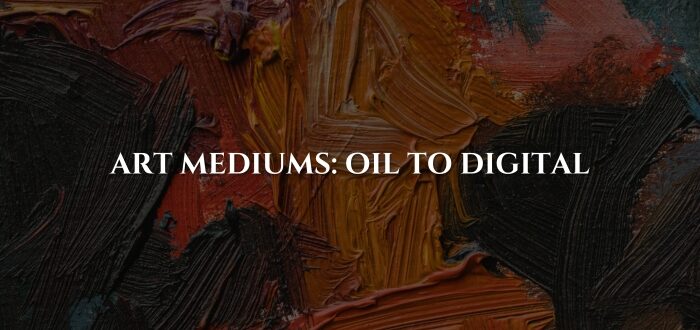From Oil to canvas: Explore Art Mediums
Art is a vast and ever-evolving world of imagination, culture, emotion, and communication. From ancient cave paintings to cutting-edge digital installations, art has always reflected the spirit of its time. But behind every artistic creation lies a crucial decision: the choice of medium.
The art medium is more than just a material—it’s the bridge between artistic vision and physical expression. Whether it’s oil on canvas or charcoal on paper, the medium matters.

In this guide, we explore the concept of medium in art, the most popular types of art media, their unique characteristics, and why the right medium can transform an idea into a timeless masterpiece.
What Is a Medium in Art?
In the simplest terms, a medium in art refers to the material or substance an artist uses to create their work. This can include paints, pencils, clay, metal, ink, textiles, wood, glass, and much more. But the term also extends to techniques, such as printmaking, sculpture, installation, or digital painting.
A medium encompasses not just what is applied, but how it is applied.
For example:
- In “oil on canvas,” the oil paint is the medium, and the canvas is the support.
- In “acrylic on wood panel,” the medium is acrylic paint, applied to a wooden base.
In this context, the plural of “medium” is media—a term often used when discussing multiple materials or works that span more than one form.

Why Medium Matters in Art
The medium an artist chooses directly shapes the visual style, texture, durability, and emotional impact of their work. Each medium has its characteristics—some are rich and slow-drying, others light and fluid. Some demand precision, while others invite spontaneity.
Here’s why the choice of medium is a vital decision for any artist:
- Aesthetic effect: The medium influences the overall look and feel of a artwork.
- Technique and control: Different media offer varying levels of control. Charcoal allows for expressive, bold strokes; pen and ink demand precision.
- Symbolic meaning: The medium can be part of the message. For example, using found objects in a collage may suggest commentary on consumerism or sustainability.
- Durability and longevity: Some materials last centuries (like oil paintings); others, such as chalk or ephemeral installation media, are more fragile or temporary.
How Mediums Shape Artistic Styles
Every art medium brings its own set of characteristics, influencing not only the final appearance of a work but also the techniques and style an artist employs.
Different media naturally lend themselves to different stylistic outcomes:
- Graphite and pencils allow for fine lines and precise detailing, which often results in realistic, intricate drawings.
- Oil paints, known for their richness and slow drying time, offer vibrant colours, depth, and texture.
- Watercolours, with their fluidity and transparency, produce light, atmospheric works that often emphasize spontaneity and softness.
Popular Types of Art Media and Techniques
Let’s explore some of the most commonly used art media and how they shape the artist’s expression:
-
Oil Paint
Oil painting remains one of the most revered and enduring art media. Known for its rich, luminous quality and slow drying time, it allows artists to build layers, blend colours, and achieve stunning depth and realism.
Surface: Canvas (cotton or linen stretched over a wooden frame)
Example: Raja Ravi Varma famously used oil paints to create detailed mythological and portrait works that revolutionized Indian art.
-
Acrylic Paint
Acrylics are water-based but dry quickly and offer vibrant pigmentation. They are incredibly versatile and can mimic the look of both oil and watercolour.
Think of acrylic painting as a modern evolution of oil painting, offering speed and adaptability.
Surface: Canvas, wood, paper
Example: M.F. Husain often used acrylics for his large, bold, and colorful compositions.

-
Watercolour
Watercolour is celebrated for its transparency, delicacy, and lightness, creating soft, fluid effects.
Surface: Watercolour paper (100% cotton preferred)
Example: Bikash Bhattacharjee used watercolour to achieve detailed, atmospheric realism in his portraits and cityscapes.
-
Charcoal Sketches
Charcoal is a raw and expressive medium, perfect for quick sketches, studies, and dramatic, textured drawings.
Surface: Textured paper
Example: Jogen Chowdhury is known for his evocative charcoal and ink drawings.
-
Ink and Pen
Ink offers clean, crisp lines and strong contrast, used in everything from calligraphy to detailed fine illustrations. Artists work with dip pens, brushes, and technical pens for various effects.
Surface: Paper, parchment
Example: Jamini Roy often employed bold ink lines to define his folk-inspired figures.
-
Mixed Media
Mixed media brings together variety, distinction, and interpretation. By combining different materials—such as paint, fabric, and found objects—artists create layered and textured works of art like collage.
Example: Atul Dodiya masterfully blends painting with photography, installation elements, and found materials.
-
Clay and Pottery
Clay has been a key material for centuries, used for functional and decorative art. Pottery focuses on moulding and sculpting clay, shaping it on a wheel, firing it in a kiln, and glazing for final finishes.
Process: Hand-moulded or pottery wheel
Example: Traditional Indian pottery like Khavda pottery from Gujarat continues this ancient medium.
-
Metal Sculpture
Metal sculpture involves working with bronze, steel, copper, and other metals to create durable and intricate three-dimensional artworks. It often requires techniques like welding, casting, and forging.
Surface/Process: Moulded, cast, or welded metal
Example: Himmat Shah is known for his distinctive bronze sculptures and terracotta works.
-
Performance and Installation Art
Performance and installation art blur the lines between art and life. These mediums involve live performances, immersive spaces, sound, light, and viewer interaction to create experiences rather than static objects.
Example: Nikhil Chopra is known for his performance-based installations, merging theatre, drawing, and endurance to explore identity, history, and memory.
Final Thoughts
Each medium carries its own language, possibilities, and challenges. The choice of medium not only shapes the artistic process but also deeply impacts the final message and emotional resonance of the work. Indian artists across generations have embraced and expanded the potential of each medium, making their mark both locally and globally.
Understanding the role of medium enriches our appreciation of art, because in every brushstroke, cast, sketch, or click, the material matters just as much as the message.
Giftex Modern & Contemporary Art Auction 2025
This May, the Giftex Modern and Contemporary Art Auction returns with a powerful lineup of renowned artists, diverse styles, and multiple mediums—from oil on canvas and acrylic paintings to sculptures and mixed media works.
With something for every collector and art enthusiast, this auction offers a unique opportunity to acquire exceptional pieces across genres and generations.
Don’t miss your chance to explore, bid, and bring home a masterpiece.






